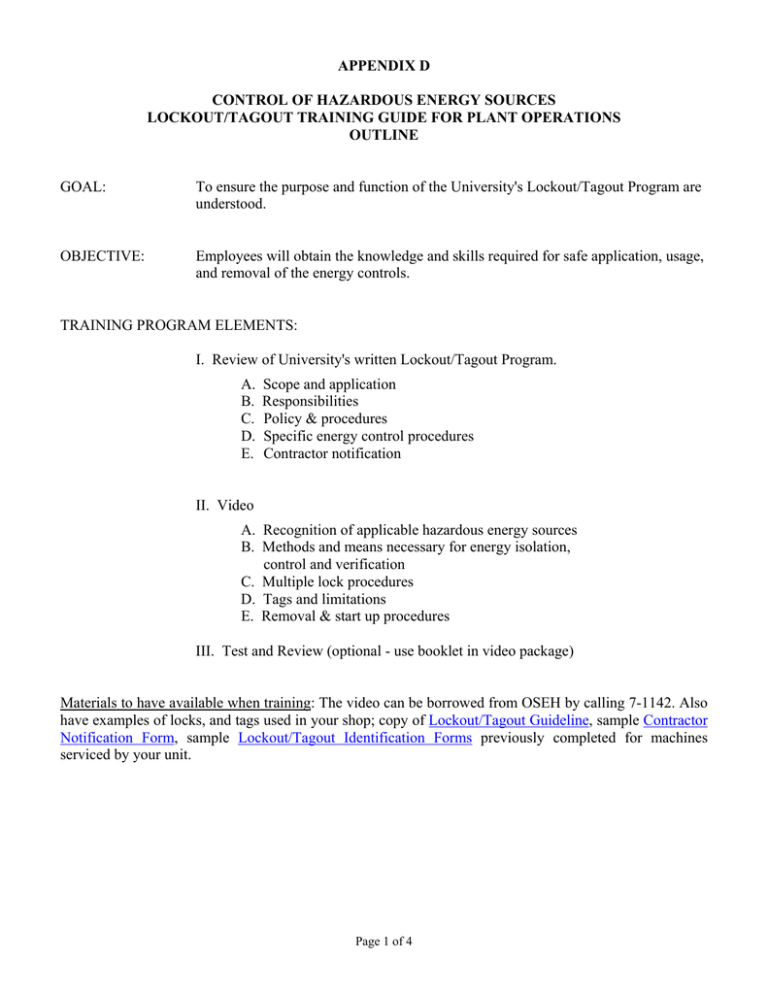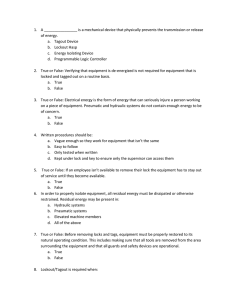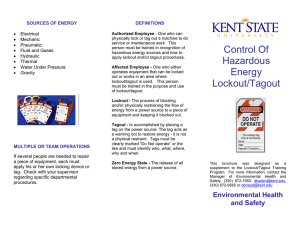Lockout/Tagout Training Guide for Plant Operations
advertisement

APPENDIX D CONTROL OF HAZARDOUS ENERGY SOURCES LOCKOUT/TAGOUT TRAINING GUIDE FOR PLANT OPERATIONS OUTLINE GOAL: To ensure the purpose and function of the University's Lockout/Tagout Program are understood. OBJECTIVE: Employees will obtain the knowledge and skills required for safe application, usage, and removal of the energy controls. TRAINING PROGRAM ELEMENTS: I. Review of University's written Lockout/Tagout Program. A. B. C. D. E. Scope and application Responsibilities Policy & procedures Specific energy control procedures Contractor notification II. Video A. Recognition of applicable hazardous energy sources B. Methods and means necessary for energy isolation, control and verification C. Multiple lock procedures D. Tags and limitations E. Removal & start up procedures III. Test and Review (optional - use booklet in video package) Materials to have available when training: The video can be borrowed from OSEH by calling 7-1142. Also have examples of locks, and tags used in your shop; copy of Lockout/Tagout Guideline, sample Contractor Notification Form, sample Lockout/Tagout Identification Forms previously completed for machines serviced by your unit. Page 1 of 4 DISCUSSION POINTS I. University Program - highlights to discuss at training A. Scope & Application: This Program applies to: all personnel conducting maintenance activities such as adjusting, repairing, servicing, installing, or performing other maintenance work on any equipment, machinery or processes where there is a potential for unintended release of energy or machine motion which could cause injury. Only employees who have received this training are considered “Authorized Employees” and are permitted to implement lockout/tagout procedures during these work operations. Energy sources include electrical, mechanical, hydraulic, pneumatic, chemical, thermal, and gravitational. B. Responsibilities: Supervisors: Train new employees and periodically instruct all employees on specific machine lockout/tagout procedures. Provide re-training whenever there whenever there is a change in their job assignments, a change in machines, equipment or processes that present a new hazard, or when there is a change in the energy control procedures. Effectively enforce compliance and ensure the necessary lockout/tagout devices are provided to employees. Employees: Follow procedures outline in this Program, consult their supervisors as necessary, maintain locks and tags, report any accidents immediately. C. Procedures: General procedures 1. Notify appropriate personnel (zone maintenance mechanic, building manager, or other administrators in the affected area) before shut down. 2. Use specific sequence of steps developed for shut down, isolation and control of the machine/equipment, or as documented on the Lockout/Tagout Procedure Identification form. Page 2 of 4 3. Locks will be used whenever possible. If tagout system is used, the supervisor must show that tagout will provide the same level of protection and the authorized employees must be aware of the following limitations of tags: • • • • • they do not provide a physical restraint; the tag must not be removed without authorization of the authorized person responsible for it; tags must remain legible and understandable; tags must be able to withstand the environmental conditions; and tags must be securely attached. (Show sample tag used in your unit. Tags are available through University Procurement Services.) 4. Locks must be attached so as to hold the energy-isolating device in a safe position, and there must also be a tag indicating the employee who applied the device (show sample of ID tag used in your unit). 5. After applying lock or tag, release all stored or residual energy and test that isolation and deenergization has been accomplished. The employee who applied the lock must keep possession of the key. 6. Removal procedures: remove tools and other items from area, assure equipment is operationally intact, stay at a safe distance, and notify zone supervisor and administrator of restart. Only the authorized employee who applied the lockout/tagout device may remove it. EXCEPTION: If the authorized employee that applied the lockout/tagout device to the machine or equipment is not available to remove the lock/tag, the authorized employee’s supervisor may remove the lockout/tagout device after: • Verifying that the authorized employee is not at the facility; • Making all reasonable effort to contact the authorized employee to inform them that their lockout/tagout device is going to be removed; and • Ensuring that the authorized employee that applied the device will be properly informed that the lockout/tagout has been removed upon returning to work. Special Procedures (discuss if applicable to your unit) 1. Live electrical parts shall be de-energized and locked or tagged out before any work is performed. Only qualified employees (certified electricians) may work on electric circuit parts that are not de-energized. (Only high voltage electricians can work on equipment greater than 240 Volts.) 2. Compressed gases or air can present a significant health or physical hazard. Lockout/tagout procedures pertain to maintenance of these systems. Lock main line in off position and isolate by disconnecting, blanking, or bleeding. 3. Hydraulics: lock in off position, disconnect, and bleed off residual pressure. Page 3 of 4 4. Gravity: use safety blocks or other mechanical devices. D. Specific Energy Control Procedures In addition to these general procedures, workers must follow the specific procedures developed by your unit for specific machines they will work on. The Lockout/Tagout Procedures Identification Form should be used to develop specific procedures for shut down and isolation of energy sources for specific machinery. (See Appendix B of the OSEH Lockout/Tagout Guideline.) Supervisor should review with employees all Lockout/Tagout Procedure Identification Forms developed for their unit. E. Contractor Notification: A representative for the University and a contractor representative will inform each other of their respective lockout or tagout procedures that will be used on the project and ensure that their personnel understand and comply with any restrictions and prohibitions of the energy control program to be utilized during the work. Refer to Contractor Notification Form, Appendix C of the OSEH Lockout/Tagout Guideline. II. Video Show lockout/tagout video, available on loan from OSEH (call: 7-1142). Page 4 of 4

